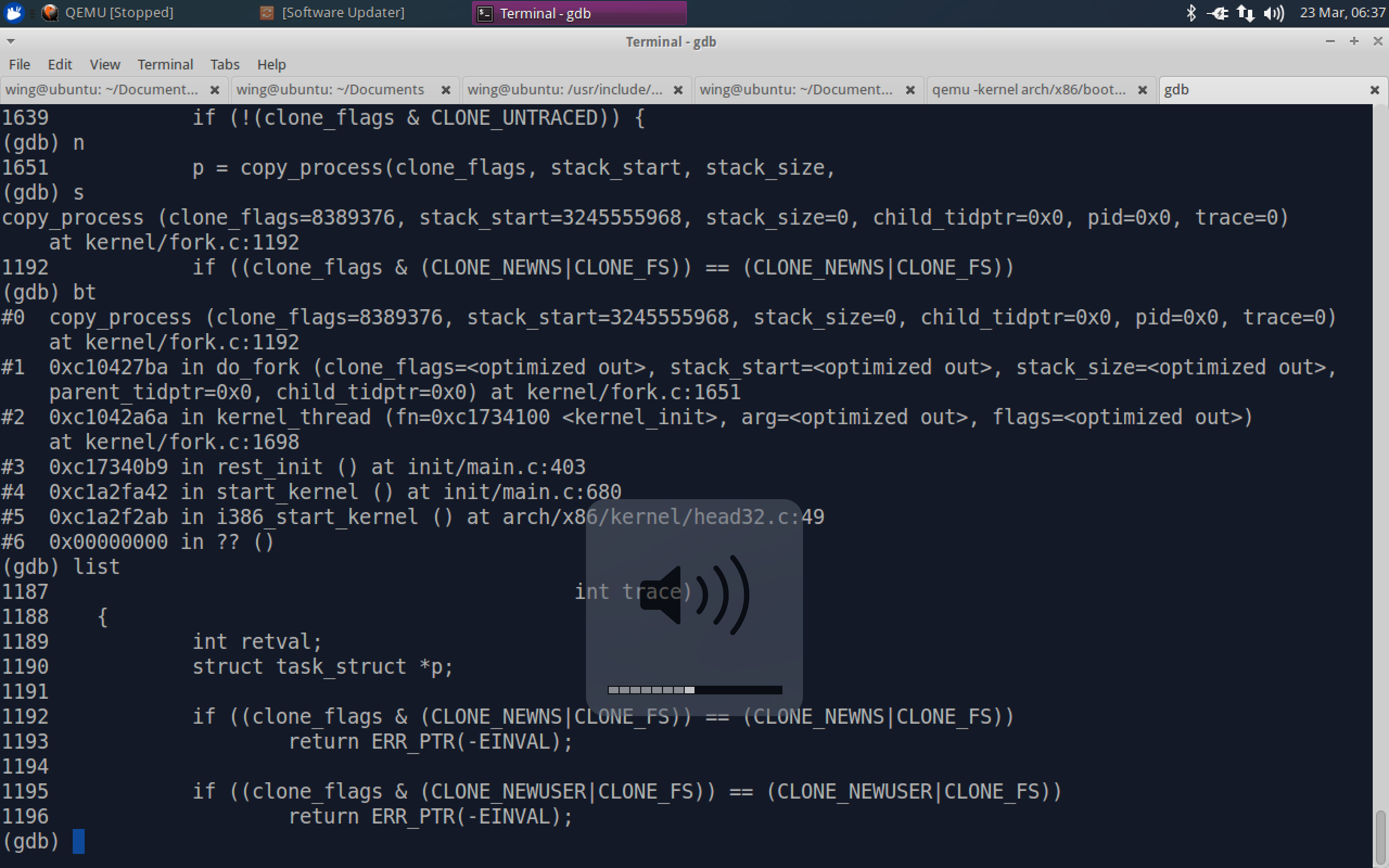环境搭建
环境的搭建参考课件,主要就是编译内核源码和生成镜像
start_kernel
从start_kernel开始,才真正进入了Linux内核的启动过程。我们可以把start_kernel看做平时用C编程时的main函数。
在平时应用程序编程中,main函数并不是一开始就启动的,而是先使用汇编和C准备一些变量,例如我们使用的argc和argv参数,以及一些全局变量的初始化。所以我们使用gdb调试程序时,使用bt打印栈痕迹,发现最下面的函数并不是main,而是__libc_start_main。
在内核启动过程中,前面的汇编代码部分,就是在为运行start_kernel这个main函数做准备。
我们看下start_kernel的代码:
asmlinkage __visible void __init start_kernel(void) { char *command_line; char *after_dashes; /* * Need to run as early as possible, to initialize the * lockdep hash: */ lockdep_init(); set_task_stack_end_magic(&init_task); smp_setup_processor_id(); debug_objects_early_init(); // ....... /* Do the rest non-__init'ed, we're now alive */ rest_init(); }
在这里我删除了大部分初始化代码,这里做以下的说明:
其实刚进入start_kernel时,Linux还没有进程的概念,整个进程只有一个控制流,在这个函数中,开始的代码主要是运行了一些初始化工作,初始化了init_task这个全局变量。此时的Linux才算是拥有了第一个进程,也就是0号进程。这些代码将start_kernel之前的代码纳入0号进程的上下文中,我们可以将这个进程看做所谓的操作系统进程。
然后我们要重点分析rest_init函数,在这个函数中,我们创建了第一个真正意义上的用户进程,也就是1号进程init。
rest_init
rest_init函数的代码如下:
static noinline void __init_refok rest_init(void) { int pid; rcu_scheduler_starting(); /* * We need to spawn init first so that it obtains pid 1, however * the init task will end up wanting to create kthreads, which, if * we schedule it before we create kthreadd, will OOPS. */ kernel_thread(kernel_init, NULL, CLONE_FS); numa_default_policy(); pid = kernel_thread(kthreadd, NULL, CLONE_FS | CLONE_FILES); rcu_read_lock(); kthreadd_task = find_task_by_pid_ns(pid, &init_pid_ns); rcu_read_unlock(); complete(&kthreadd_done); /* * The boot idle thread must execute schedule() * at least once to get things moving: */ init_idle_bootup_task(current); schedule_preempt_disabled(); /* Call into cpu_idle with preempt disabled */ cpu_startup_entry(CPUHP_ONLINE); }
在这段代码中,我们注意到kernel_thread(kernel_init, NULL, CLONE_FS);
kernel_thread函数的代码只有一行:
pid_t kernel_thread(int (*fn)(void *), void *arg, unsigned long flags) { return do_fork(flags|CLONE_VM|CLONE_UNTRACED, (unsigned long)fn, (unsigned long)arg, NULL, NULL); }
所以我们可以确定,这样代码创建一个内核线程,该线程的运行逻辑为kernel_init函数。
注意到,Linux系统实际上是没有真正的线程的,所谓的线程是通过进程模拟实现的,所以这里就是创建了一个用户进程,所谓的init。
然后我们注意到最后一行的cpu_startup_entry(CPUHP_ONLINE);
查看下cpu_startup_entry函数代码:
void cpu_startup_entry(enum cpuhp_state state) {
// ……… 省略代码 arch_cpu_idle_prepare(); cpu_idle_loop(); }
然后查看cpu_idle_loop的代码:
static void cpu_idle_loop(void) { while (1) { // ..... 省略代码 schedule_preempt_disabled(); } }
所以我们看到,rest_init函数在最后一行进入了一个死循环。
所以我们得出结论,rest_init先fork出一个真正意义的进程-1号进程init之后,进入了一个死循环,这个死循环就是0号进程idle。我们可以认为idle进程是真正意义上的操作系统进程。
kernel_init进程
下面我们查看下init进程的逻辑:
static int __ref kernel_init(void *unused) { int ret; kernel_init_freeable(); /* need to finish all async __init code before freeing the memory */ async_synchronize_full(); free_initmem(); mark_rodata_ro(); system_state = SYSTEM_RUNNING; numa_default_policy(); flush_delayed_fput(); if (ramdisk_execute_command) { ret = run_init_process(ramdisk_execute_command); if (!ret) return 0; pr_err("Failed to execute %s (error %d) ", ramdisk_execute_command, ret); } /* * We try each of these until one succeeds. * * The Bourne shell can be used instead of init if we are * trying to recover a really broken machine. */ if (execute_command) { ret = run_init_process(execute_command); if (!ret) return 0; pr_err("Failed to execute %s (error %d). Attempting defaults... ", execute_command, ret); } if (!try_to_run_init_process("/sbin/init") || !try_to_run_init_process("/etc/init") || !try_to_run_init_process("/bin/init") || !try_to_run_init_process("/bin/sh")) return 0; panic("No working init found. Try passing init= option to kernel. " "See Linux Documentation/init.txt for guidance."); }
我们注意末尾几行的:
if (!try_to_run_init_process("/sbin/init") || !try_to_run_init_process("/etc/init") || !try_to_run_init_process("/bin/init") || !try_to_run_init_process("/bin/sh")) return 0;
然后我们继续查看try_to_run_init_process函数:
static int try_to_run_init_process(const char *init_filename) { int ret; ret = run_init_process(init_filename); if (ret && ret != -ENOENT) { pr_err("Starting init: %s exists but couldn't execute it (error %d) ", init_filename, ret); } return ret; }
继续跟进run_init_process:
static int run_init_process(const char *init_filename) { argv_init[0] = init_filename; return do_execve(getname_kernel(init_filename), (const char __user *const __user *)argv_init, (const char __user *const __user *)envp_init); }
我们可以清楚地看到,run_init_process中,调用一个execve来替换当前进程的代码端,熟悉Unix编程的同学都知道,执行execve替换后,之前的代码不会继续执行,但是如果执行了,说明代码替换失败!!
所以,kernel_init中那几行代码的逻辑就很清楚了。
1.先尝试运行/sbin/init来替换本进程
2.如果上面的调用失败(/sbin/init不存在),那么尝试使用/etc/init/
………
代码中提到的这几个文件,就是init的执行逻辑。
实验截图

总结
总结上面的流程,其实就是内核fork出一个init进程,然后之前的进程进入死循环,也就是所谓的idle进程。
通过本周的作业,清晰的认识到了操作系统的启动流程。
作业署名
郭春阳 原创作品转载请注明出处 :《Linux内核分析》MOOC课程